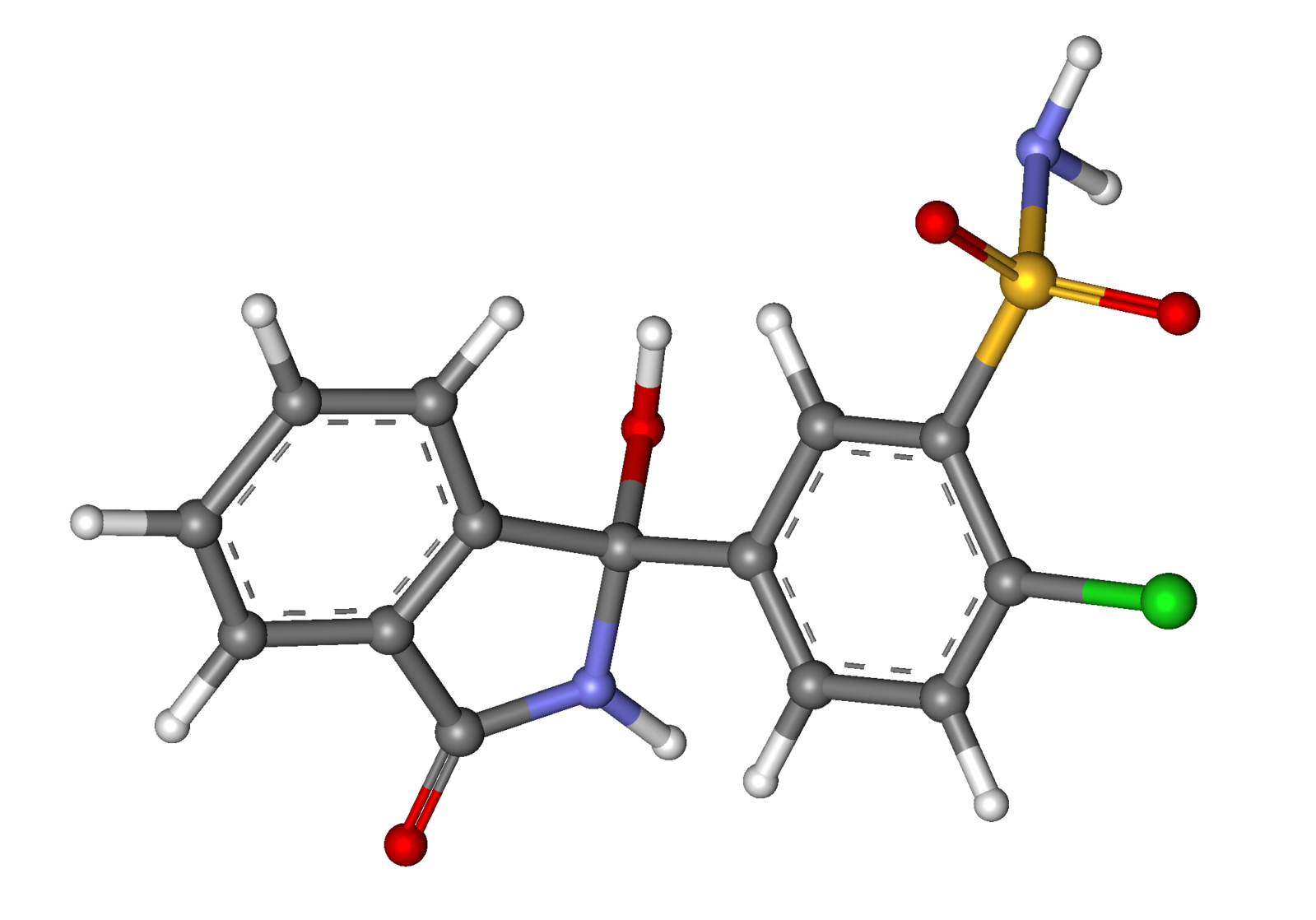Chlorthalidone
Editor-In-Chief: C. Michael Gibson, M.S., M.D. [1]; Associate Editor(s)-in-Chief: Gerald Chi
Disclaimer
WikiDoc MAKES NO GUARANTEE OF VALIDITY. WikiDoc is not a professional health care provider, nor is it a suitable replacement for a licensed healthcare provider. WikiDoc is intended to be an educational tool, not a tool for any form of healthcare delivery. The educational content on WikiDoc drug pages is based upon the FDA package insert, National Library of Medicine content and practice guidelines / consensus statements. WikiDoc does not promote the administration of any medication or device that is not consistent with its labeling. Please read our full disclaimer here.
Overview
Chlorthalidone is a thiazide-like diuretic that is FDA approved for the {{{indicationType}}} of hypertension and edema associated with congestive heart failure, hepatic cirrhosis, and corticosteroid and estrogen therapy. Common adverse reactions include dizziness, lightheadedness, and hyperuricemia.
Adult Indications and Dosage
FDA-Labeled Indications and Dosage (Adult)
- Therapy should be initiated with the lowest possible dose, then titrated according to individual patient response. A single dose given in the morning with food is recommended; divided doses are unnecessary.
Hypertension
- Dosing Information
- Initial dose: 15 mg PO qd
- If the response is insufficient after a suitable trial, the dosage may be increased to 30 mg and then to a single daily dose of 45–50 mg.
- If additional control is required, the addition of a second antihypertensive drug is recommended.
- Increases in serum uric acid and decreases in serum potassium are dose-related over the 15–50 mg/day range and beyond.
Edema
- Dosing Information
- Initial dose: Adults, initially 30–60 mg PO qd or 60 mg PO qod.
- Some patients may require 90–120 mg at these intervals or up to 120 mg daily. Dosages above this level, however, do not usually produce a greater response.
- Maintenance dose: maintenance doses may often be lower than initial doses and should be adjusted according to the individual patient.
Off-Label Use and Dosage (Adult)
Guideline-Supported Use
There is limited information regarding Off-Label Guideline-Supported Use of Chlorthalidone in adult patients.
Non–Guideline-Supported Use
Hypertension as in Stroke Prophylaxis
- Dosing Information
- 12.5–25 mg PO qd[1]
Left Ventricular Hypertrophy
- Dosing Information
- 100 mg PO qd[2]
Ménière's Disease
- Dosing Information
- 50–200 mg PO qd[3]
Pediatric Indications and Dosage
FDA-Labeled Indications and Dosage (Pediatric)
Safety and effectiveness in children have not been established.
Off-Label Use and Dosage (Pediatric)
Guideline-Supported Use
There is limited information regarding Off-Label Guideline-Supported Use of Chlorthalidone in pediatric patients.
Non–Guideline-Supported Use
There is limited information regarding Off-Label Non–Guideline-Supported Use of Chlorthalidone in pediatric patients.
Contraindications
- Anuria
- Hypersensitivity to chlorthalidone or other sulfonamide-derived drugs
Warnings
- Thalitone® (chlorthalidone USP) should be used with caution in severe renal disease. In patients with renal disease, chlorthalidone or related drugs may precipitate azotemia. Cumulative effects of the drug may develop in patients with impaired renal function.
- Chlorthalidone should be used with caution in patients with impaired hepatic function or progressive liver disease, because minor alterations of fluid and electrolyte balance may precipitate hepatic coma.
- Sensitivity reactions may occur in patients with a history of allergy or bronchial asthma.
- The possibility of exacerbation or activation of systemic lupus erythematosus has been reported with thiazide diuretics which are structurally related to chlorthalidone. However, systemic lupus erythematosus has not been reported following chlorthalidone administration.
Precautions
- General
- Hypokalemia and other electrolyte abnormalities, including hyponatremia and hypochloremic alkalosis, are common in patients receiving chlorthalidone. These abnormalities are dose-related but may occur even at the lowest marketed doses of chlorthalidone. Serum electrolytes should be determined before initiating therapy and at periodic intervals during therapy. Serum and urine electrolyte determinations are particularly important when the patient is vomiting excessively or receiving parenteral fluids. All patients taking chlorthalidone should be observed for clinical signs of electrolyte imbalance, including dryness of mouth, thirst, weakness, lethargy, drowsiness, restlessness, muscle pains or cramps, muscular fatigue, hypotension, oliguria, tachycardia, palpitations, and gastrointestinal disturbances, such as nausea and vomiting.
- Digitalis therapy may exaggerate metabolic effects of hypokalemia especially with reference to myocardial activity.
- Any chloride deficit is generally mild and usually does not require specific treatment except under extraordinary circumstances (as in liver disease or renal disease). Dilutional hyponatremia may occur in edematous patients in hot weather; appropriate therapy is water restriction, rather than administration of salt, except in rare instances when the hyponatremia is life-threatening. In cases of actual salt depletion, appropriate replacement is the therapy of choice.
- Thiazide-like diuretics have been shown to increase the urinary excretion of magnesium; this may result in hypomagnesemia.
- Calcium excretion is decreased by thiazide-like drugs. Pathological changes in the parathyroid gland with hypercalcemia and hypophosphatemia have been observed in a few patients on thiazide therapy. The common complications of hyperparathyroidism such as renal lithiasis, bone resorption and peptic ulceration have not been seen.
- Hyperuricemia may occur or frank gout may be precipitated in certain patients receiving chlorthalidone.
- Other
- Increases in serum glucose may occur and latent diabetes mellitus may become manifest during chlorthalidone therapy. Chlorthalidone and related drugs may decrease serum protein-bound iodine (PBI) levels without signs of thyroid disturbance.
- Laboratory Tests
- Periodic determination of serum electrolytes to detect possible electrolyte imbalance should be performed at appropriate intervals.
- All patients receiving chlorthalidone should be observed for clinical signs of fluid or electrolyte imbalance: namely, hyponatremia, hypochloremic alkalosis and hypokalemia. Serum and urine electrolyte determinations are particularly important when the patient is vomiting excessively or receiving parenteral fluids.
Adverse Reactions
Clinical Trials Experience
There is limited information regarding Clinical Trial Experience of Chlorthalidone in the drug label.
Postmarketing Experience
- Whenever adverse reactions are moderate or severe, chlorthalidone dosage should be reduced or therapy withdrawn.
- The following adverse reactions have been observed, but there is not enough systematic collection of data to support an estimate of their frequency.
Central Nervous System
Dizziness, vertigo, paresthesias, headache, and xanthopsia
Cardiovascular
Orthostatic hypotension may occur and may be aggravated by alcohol, barbiturates or narcotics.
Gastrointestinal
Anorexia, gastric irritation, nausea, vomiting, cramping, diarrhea, constipation, jaundice (intrahepatic cholestatic jaundice), pancreatitis
Hematologic Reactions
Leukopenia, agranulocytosis, thrombocytopenia, and aplastic anemia
Hypersensitivity
Purpura, photosensitivity, rash, urticaria, necrotizing angiitis (cutaneous vasculitis), Lyell's syndrome (toxic epidermal necrolysis)
Miscellaneous
Hyperglycemia, glycosuria, hyperuricemia, muscle spasm, weakness, restlessness, impotence
Drug Interactions
- Drug
- Description
Use in Specific Populations
Pregnancy
- Pregnancy Category B
- Australian Drug Evaluation Committee (ADEC) Pregnancy Category C
There is no Australian Drug Evaluation Committee (ADEC) guidance on usage of Chlorthalidone in women who are pregnant.
Labor and Delivery
There is no FDA guidance on use of Chlorthalidone during labor and delivery.
Nursing Mothers
There is no FDA guidance on the use of Chlorthalidone with respect to nursing mothers.
Pediatric Use
There is no FDA guidance on the use of Chlorthalidone with respect to pediatric patients.
Geriatic Use
There is no FDA guidance on the use of Chlorthalidone with respect to geriatric patients.
Gender
There is no FDA guidance on the use of Chlorthalidone with respect to specific gender populations.
Race
There is no FDA guidance on the use of Chlorthalidone with respect to specific racial populations.
Renal Impairment
There is no FDA guidance on the use of Chlorthalidone in patients with renal impairment.
Hepatic Impairment
There is no FDA guidance on the use of Chlorthalidone in patients with hepatic impairment.
Females of Reproductive Potential and Males
There is no FDA guidance on the use of Chlorthalidone in women of reproductive potentials and males.
Immunocompromised Patients
There is no FDA guidance one the use of Chlorthalidone in patients who are immunocompromised.
Administration and Monitoring
Administration
Oral
Intravenous
Monitoring
There is limited information regarding Monitoring of Chlorthalidone in the drug label.
Condition1
Description
IV Compatibility
There is limited information regarding IV Compatibility of Chlorthalidone in the drug label.
Overdosage
Acute Overdose
Signs and Symptoms
Description
Management
Description
Chronic Overdose
There is limited information regarding Chronic Overdose of Chlorthalidone in the drug label.
Pharmacology

| |

| |
1 : 1 mixture (racemate)Chlortalidone
| |
| Systematic (IUPAC) name | |
| (RS)-2-Chloro-5-(1-hydroxy-3-oxo-2,3-dihydro-1H-isoindol-1-yl)benzene-1-sulfonamide | |
| Identifiers | |
| CAS number | |
| ATC code | C03 |
| PubChem | |
| DrugBank | |
| Chemical data | |
| Formula | Template:OrganicBox atomTemplate:OrganicBox atomTemplate:OrganicBoxTemplate:OrganicBoxTemplate:OrganicBoxTemplate:OrganicBoxTemplate:OrganicBox atomTemplate:OrganicBoxTemplate:OrganicBoxTemplate:OrganicBoxTemplate:OrganicBoxTemplate:OrganicBoxTemplate:OrganicBoxTemplate:OrganicBox atomTemplate:OrganicBoxTemplate:OrganicBox atomTemplate:OrganicBoxTemplate:OrganicBoxTemplate:OrganicBox atomTemplate:OrganicBoxTemplate:OrganicBoxTemplate:OrganicBoxTemplate:OrganicBox |
| Mol. mass | 338.766 g/mol |
| SMILES | & |
| Pharmacokinetic data | |
| Bioavailability | ? |
| Protein binding | 75% |
| Metabolism | ? |
| Half life | 40 hours |
| Excretion | Renal |
| Therapeutic considerations | |
| Pregnancy cat. | |
| Legal status | |
| Routes | Oral |
Mechanism of Action
There is limited information regarding Chlorthalidone Mechanism of Action in the drug label.
Structure
There is limited information regarding Structure of Chlorthalidone in the drug label.
Pharmacodynamics
There is limited information regarding Pharmacodynamics of Chlorthalidone in the drug label.
Pharmacokinetics
There is limited information regarding Pharmacokinetics of Chlorthalidone in the drug label.
Nonclinical Toxicology
There is limited information regarding Nonclinical Toxicology of Chlorthalidone in the drug label.
Clinical Studies
There is limited information regarding Clinical Studies of Chlorthalidone in the drug label.
Condition1
Description
How Supplied
- White, kidney-shaped, compressed tablets coded M/024 containing 15 mg of chlorthalidone in bottles of 100 (NDC 61570-024-01).
- Storage: Store below 30°C (86°F).
Storage
There is limited information regarding Chlorthalidone Storage in the drug label.
Images
Drug Images
{{#ask: Page Name::Chlorthalidone |?Pill Name |?Drug Name |?Pill Ingred |?Pill Imprint |?Pill Dosage |?Pill Color |?Pill Shape |?Pill Size (mm) |?Pill Scoring |?NDC |?Drug Author |format=template |template=DrugPageImages |mainlabel=- |sort=Pill Name }}
Package and Label Display Panel
{{#ask: Label Page::Chlorthalidone |?Label Name |format=template |template=DrugLabelImages |mainlabel=- |sort=Label Page }}
Patient Counseling Information
- Patients should inform their doctor if they have:
- Allergic reaction to chlorthalidone or other diuretics or have asthma
- Kidney disease
- Liver disease
- Gout
- Systemic lupus erythematosus
- Taking other drugs such as cortisone, digitalis, lithium carbonate, or drugs for diabetes
- Patients should be cautioned to contact their physician if they experience any of the following symptoms of potassium loss: excess thirst, tiredness, drowsiness, restlessness, muscle pains or cramps, nausea, vomiting or increased heart rate or pulse.
- Patients should also be cautioned that taking alcohol can increase the chance of dizziness occurring.
Precautions with Alcohol
Orthostatic hypotension may occur and may be aggravated by alcohol. Patients should be cautioned that taking alcohol can increase the chance of dizziness occurring.
Brand Names
Thalitone®[4]
Look-Alike Drug Names
N/A[5]
Drug Shortage Status
Price
References
The contents of this FDA label are provided by the National Library of Medicine.
- ↑ Perry, HM.; Davis, BR.; Price, TR.; Applegate, WB.; Fields, WS.; Guralnik, JM.; Kuller, L.; Pressel, S.; Stamler, J. (2000). "Effect of treating isolated systolic hypertension on the risk of developing various types and subtypes of stroke: the Systolic Hypertension in the Elderly Program (SHEP)". JAMA. 284 (4): 465–71. PMID 10904510. Unknown parameter
|month=ignored (help) - ↑ Cherchi, A.; Sau, F.; Seguro, C. (1987). "Possible regression of left ventricular hypertrophy during antihypertensive treatment with diuretics and/or beta blockers". J Clin Hypertens. 3 (2): 216–25. PMID 2886561. Unknown parameter
|month=ignored (help) - ↑ Klockhoff, I.; Lindblom, U.; Stahle, J. (1974). "Diuretic treatment of Meniere disease. Long-term results with chlorthalidone". Arch Otolaryngol. 100 (4): 262–5. PMID 4412853. Unknown parameter
|month=ignored (help) - ↑ "THALITONE (CHLORTHALIDONE) TABLET [MONARCH PHARMACEUTICALS, INC]". Retrieved 30 June 2014.
- ↑ "http://www.ismp.org". External link in
|title=(help)
{{#subobject:
|Page Name=Chlorthalidone |Pill Name=No image.jpg |Drug Name= |Pill Ingred=|+sep=; |Pill Imprint= |Pill Dosage= |Pill Color=|+sep=; |Pill Shape= |Pill Size (mm)= |Pill Scoring= |Pill Image= |Drug Author= |NDC=
}}
{{#subobject:
|Label Page=Chlorthalidone |Label Name=No image.jpg
}}